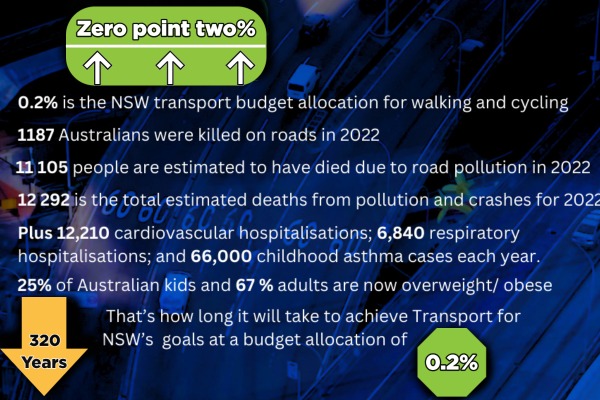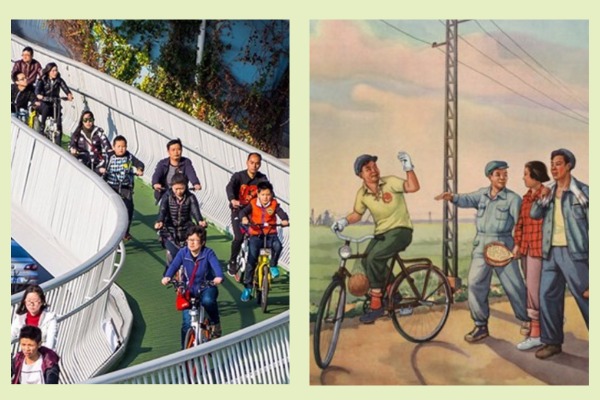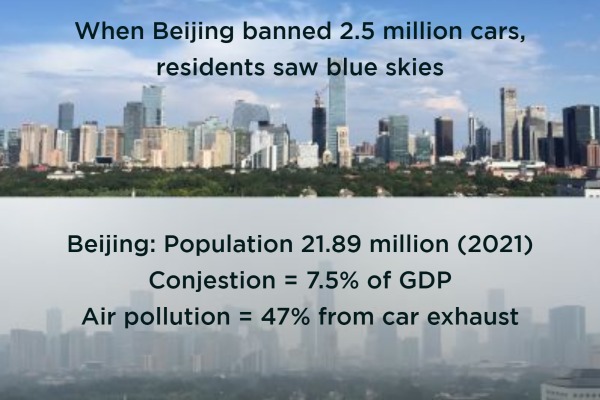China (re-)embraces active transport as Australia stays gridlocked
Different cities are at different stages along their paths to sustainable mobility. Australia for instance, has developed fine documents like the NSW Future Transport and Active Transport strategies. Or the Movement and Place framework. For example, the NSW Active Transport Strategy discusses the need to walk and cycle more, and drive less. It also talks about active kids, connected public transport, building better streets and reducing private car reliance. It even acknowledges the massive cost burden of car-dependence upon our health, the economy and the environment.
But without funding or a timeline, it’s all just words in the wind.
The world’s longest elevated bike path, Beijing. Credit: Cycling Today
Zero point two percent is the epitome of failure.
The UN recommends that 20% of a country’s transport budget should go towards walking and cycling. But NSW only allocates 0.2%. Therefore, by that standard, Australia has achieved failure. And at the rate of 0.2%, it will take NSW at least 320 years to achieve its active transport goals.
But the great thing about failure is that there’s nowhere else to go but up.
So Bicycle NSW and Better Streets are saying that governments need to allocate 5%. And yes, 5% is shamefully below the UN benchmark, but it’s achievable. Besides - with a funded plan our kids won’t be 320 years older before they can walk and bike to school.
Meanwhile, China has embraced its active transport roots
Let’s leave aside the fact that China is a command economy. Or the six million justifications for the six million daily car trips in Greater Sydney alone that are under 5km. China is racing ahead with infrastructure prioritising walking and cycling.
Image credits: WeRide, Australia; Zhang Quangyi, On the way to the new sports field, 1954, ChinesePosters.net
According to World Bank Transport Analyst Sam Johnson, China recognizes the extensive advantages for population health, wellbeing, productivity, decongestion, and decarbonisation. Additionally, these benefits have a positive impact on the economy. Whilst motorways result in a loss, bike infrastructure offers a minimum return on investment of 5:1, or 500%.
It's ironic moreover, that a command economy like China has made the economically rational decision to prioritize people over cars. Meanwhile, Australia remains ideologically attached to a car-first paradigm
The baby and the bath water: Shifting from a car-first to a people-first paradigm
In the 1980s, under Deng Xiaoping, China’s economy opened up to western trade. As a result, the newly cashed-up middle class ditched their bikes for cars. What followed was a lightning version of the industrial revolution complete with motorways, congestion, deadly pollution, collisions and poor population health.
So, realising that in adopting market capitalism it had thrown out something precious, China adapted yet again, at light speed. Between 2010- 2021, 80,000 km of greenways were built. Plus innumerable walking and biking share paths and lanes. “That’s 800 times the distance between Sydney and Melbourne,” notes Sam Johnson.
The problem with Beijing and the solution
Google ‘smog’ and you’ll be taken to the deadly whiteness of Beijing. 47% of the pollution comes from motor vehicles. But over recent years there has been significant improvement through a stick and carrot approach. This included a car diet, strict parking and pollution controls and massive investment in walking and cycling. From 2018- 2020, car use decreased by 3.8% while bike traffic increased by 23.6% to reach a 15.3% mode share.
Lose the cars and Beijing regained its international credibility (Credit: The Beijinjer)
Based on its successes, Beijing is accelerating infrastructure development
With its population fully reaping the public health and mobility rewards, the government has launched increasingly ambitious plans. “Beijing has committed that by 2025, for all roads wider than 12 metres, there must be a bicycle lane,” says Sam Johnson. Imagine this happening in Australia!
The plans for walking and cycling are really mind-blowing. For more information, check out Sam Johnson’s presentation: “What we can learn from China’s active mobility infrastructure boom?”
Support our campaign for better infrastructure for walking and cycling
We need to get from car-first to people-first cities and towns. So, we're campaigning to raise active transport funding from 0.2% to 5%. But it’s not just about lack of money. There’s also a whole lot of bureaucratic red tape holding back great projects. So we’re asking you to join us and fight for a better future in any of the following ways:
- Join Bicycle NSW and support our bike advocacy
- Volunteer with Better Streets
- Write to your local member asking them to do more to create better streets. You’re welcome to quote the statistics in this article!






